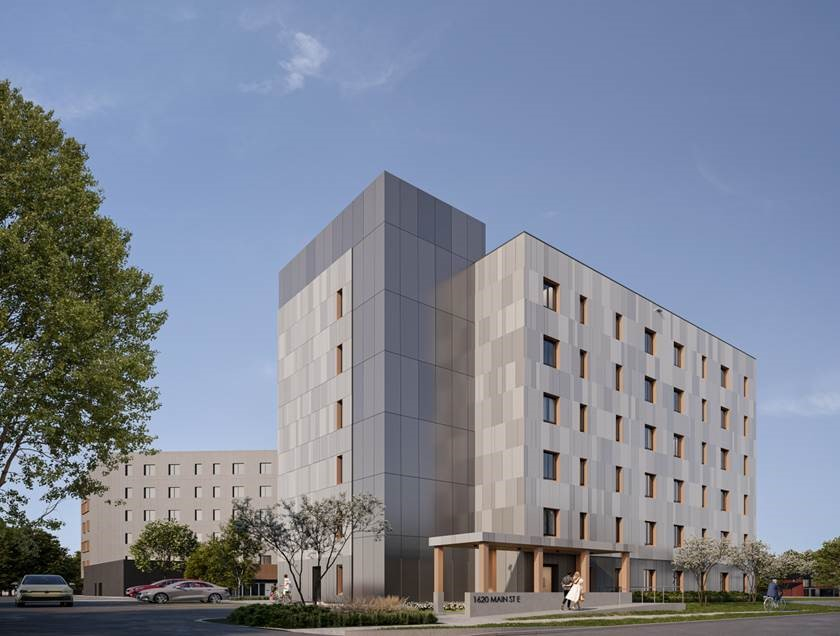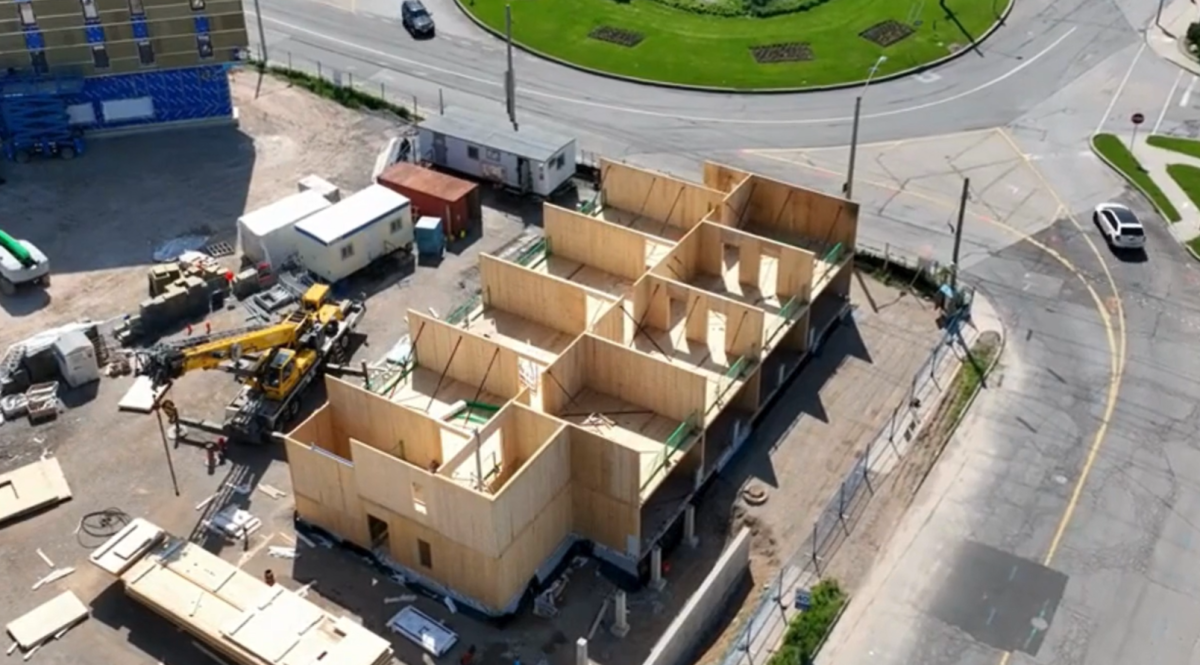Support strong Canadian climate journalism for 2025
Canada is at a critical juncture — our housing market is unaffordable for many and our environmental goals are becoming increasingly urgent. As policymakers scramble to address these interconnected crises, numerous initiatives have been launched to tackle the affordable housing shortage and meet sustainability targets.
But these well-intentioned efforts often miss the mark. Instead of perpetually searching for new ideas, Canada should focus on identifying, supporting and scaling the innovative solutions that are already being implemented by forward-thinking collaborators within the construction industry. By doing so, we can create a more sustainable, affordable and equitable housing landscape for all Canadians.
Many recent government-led initiatives — including competitions, grants and calls for proposals — are aimed at generating novel solutions to our housing woes. While these programs have produced some promising concepts, they often fail to translate into real-world impact. Ideas alone are not enough.
They must be paired with the knowledge, experience, resourcefulness and resiliency of those that can execute the idea. The Canadian housing market does not suffer from a lack of ideas. It suffers from a lack of execution. The constant quest for new ideas can create a cycle of inaction, where policymakers are so focused on finding the next big thing that they overlook the effective solutions already being implemented.
This approach also risks sidelining or delaying the innovators within the construction industry who are making significant strides in building affordable, sustainable housing. We need to empower those who have proven themselves capable of execution and facilitate their continued growth.
Across Canada, there are numerous examples of successful projects that combine affordability with sustainability. From low-rise and mid-rise developments to high-rise buildings and from urban infill projects to suburban developments, construction industry leaders are pioneering new ways to deliver housing that offer both.
At mcCallumSather, we have been fortunate to work with various partners on the design, construction, and occupancy of several impactful projects in recent years.

1620 Main St. E., designed by mcCallumSather, is set to become one of North America's first mass-timber Passive House multi-residential buildings. Currently under construction in Hamilton, Ont, it is expected to be completed by the end of 2024. Photo by mcCallumSather
Our interests and those of our partners have been rooted in the growing use of prefabricated and modular construction techniques (particularly low embodied carbon materials such as mass timber). These methods allow for faster, more efficient building processes that reduce waste and help bring down upfront capital costs.
When paired with passive design principles and net-zero energy use (using non-fossil fuel burning equipment and renewable energy production), these projects can achieve significant reductions in long-term operational costs. These up-front capital cost savings and long-term operational savings allow these innovative building solutions to be provided inclusively to the entire housing market.
The Housing Continuum of Need (as identified by CMHC) ranges from emergency shelters and transitional housing, to affordable rental units and home-ownership opportunities. Regardless of where a given resident may find themselves in the continuum of need, we believe a standardized, yet adaptable system (such as the mass timber system used in our rapid housing delivery projects) can be used to create healthy and sustainable housing capable of meeting one’s specific requirements and expectations (i.e. unit size, finish, amenities, etc.).
Rather than continuing to launch new programs in search of ideas, the Canadian government should focus on identifying and supporting the innovators who are already making a difference. This support could be achieved through public recognition with awards, case studies and media campaigns that showcase the best examples of affordable and sustainable housing in Canada. By making these projects more visible, we can inspire other developers, architects and builders to follow suit, creating a culture of innovation and excellence in the industry.
That said, supporting and scaling the efforts of innovators in the housing industry is not just about recognizing their achievements; it’s about creating the conditions for these successes to be replicated and expanded.
This means removing regulatory barriers to innovation and investing in research and development to continue advancing construction technologies and practices. A great example of this would be the current initiative to allow for a single common exit stair (instead of two exits) in mid-rise, multi-unit residential projects. This provision (which would still require various life and fire safety measures) would allow for flexible, new solutions for missing middle housing that are proven to be safe and successful in many other countries around the world.
This can and should include study of, travel to and engagement with other countries known for the successful execution of sustainable and innovative housing. Recent trips from our office to various European countries such as Denmark, Sweden and the Netherlands have provided a wealth of references and contacts to help continue our ambitious work.
Canada’s affordable housing crisis and sustainability targets require urgent action, not endless ideation. The solutions we need, such as prefabrication, rapid delivery, low carbon, net-zero, etc., are already being implemented by forward-thinking collaborators in the construction industry.
By shifting our focus from searching for new ideas to supporting and scaling up existing innovations, we can create a housing market that is affordable, sustainable and accessible to all Canadians — but the time to act is now.
Matt Bolen, a managing principal at mcCallumSather, is immersed in combining his deep understanding of conventional construction with advanced research and innovative development initiatives.






Comments
“This means removing regulatory barriers to innovation and investing in research and development to continue advancing construction technologies and practices.”
“Canada’s affordable housing crisis and sustainability targets require urgent action, not endless ideation.”
Can you spot the contradiction between the two paragraphs above?
With the phrase, “regulatory barriers”, if the author is referring to such things as the ability to replace stick/ manufactured insulation walls with, say, straw bales, then I’d agree that such prohibitions are counterproductive.
And I also heartily applaud cross-fertilization of knowledge and experience, whether ancient or recent, particularly from Europe but also from historically hot (and getting hotter) locales around the planetary middle.
Missing from this opinion was any broader notion of regulation – e.g. meet-the-moment building codes or any sort of engineering codes/ heuristics (over which one can argue between prescriptive vs performance-based) – that mandate minimum high standards of performance (enforceable by punitive, personal -- not merely corporate, which can be dodged -- financial penalties) and demand-side measures to reduce ridiculous inflationary, market pressures. (My childhood family home in Point Grey, Vancouver, cost my parents around $25k in ’62. A recent-ish assessment put it at ~$4M. It’s left as an exercise to calculate what value would be assessed 60 years hence at a similar rate of value inflation.
Building on that realization, also missing was the foundational idea of removing from the vernacular the entire idea of investing in residential real estate. Having a safe and secure, warm place to lay one’s head is a right in any civilized society, IMO, not something gained or lost by a roll of the dice, assuming one is even able to be standing at the craps table, in this artificial thing we call the market.
Very much to the point. It is the housing MARKET that is broken, not the house building industry. It has been financialized!
The usual response to a broken market in a consequential area is government intervention on behalf of community wellbeing. Time to re-instate municipal building programs that can harness all these wonderful new building techniques by financing the BUILD. Cheap federal and provincial land would be a bonus and stimulant. But OUTSIDE the MARKET.
Picked this article up with some hope, put it down disappointed. I thought there would be some list of these successful projects we just have to scale. Not one was mentioned. The usual stuff about "we have to clear barriers" that EVERY housing article for a couple of years has repeated.
I think the one project with mass timber - which is a new thing, probably expensive, not at all an immediate solution to a build-fast crisis - was added by an editor, so the article would have a picture. And a mention of ONE actual building example.
And the building pictured looks like a refugee from a Soviet Brutalist design school!
Check out Lloyd Alter's Substack newsletter on upfront carbon and building. The current style of all-glass and huge windows doesn't cut it in a climate emergency.
Matt's article might not have been entirely consistent, but let's not lose the message. Like with so many other climate solutions, we (mostly) know what to do - we need to get doing it.
https://substack.com/@lloydalter